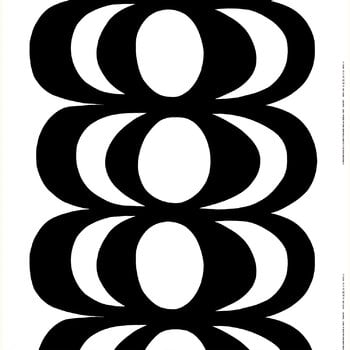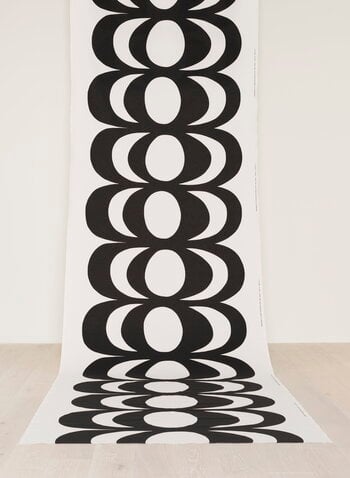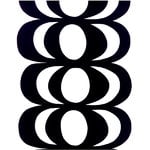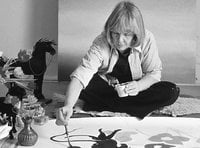Marimekko’s Kaivo (Finnish for ”well”) was created by the designer Maija Isola, who got the inspiration at a well while watching the rings that formed on the surface of the water. The heavyweight cotton has been printed in Helsinki, Finland.
Kaivo fabric, white-black
Marimekko
Description
Marimekko’s Kaivo (Finnish for ”well”) was created by the designer Maija Isola, who got the inspiration at a well while watching the rings that formed on the surface of the water. The heavyweight cotton has been printed in Helsinki, Finland.
Product details (5)
- Material
- 100 % heavyweight cotton
- Colour
- White, black
- Size
- Width 58.27 in (148 cm) (+-2 %)
- Repeat
- 34.65 in (88 cm)
- Notes
-
This fabric is sold by the meter and comes in one continuous length. Add the number of meters required into the Quantity box.
Please note that the maximum continuous length is 15 meters.
Designer
Maija Isola (1927–2001) is probably Marimekko’s most famous designer. The Finnish artist designed her first printed textiles in 1949 for Printex Oy, Marimekko’s predecessor. She worked as head designer of Marimekko’s interior fabrics until 1987. She also had an illustrious career as a visual artist.
Maija Isola was a tremendously versatile and bold artist. She interpreted the events of her era from her own unique perspective and foresaw future trends. Her body of work includes over 500 prints – a brilliant selection of patterns representing different themes and techniques. She drew inspiration from traditional folk art, modern visual art, nature and her countless trips around the world. In the 1980s, she began designing fabrics with her daughter, Kristina. Together they produced fresh floral fabrics, bold abstract patterns and ornamental designs that became Marimekko staples. When Maija passed away in 2001, Kristina carried on her mother’s tradition, producing new color waves of Maija’s classic designs.
Maija Isola’s most well-known pattern is the flowery Unikko. The Unikko pattern came about in 1964 after Armi Ratia, the founder of Marimekko, had announced in public that no floral fabrics are designed at Marimekko. Maija Isola did not accept rules or restrictions and designed in protest a complete collection of bold floral patterns: Unikko, a Finnish word that means poppy. Today, Unikko is probably more popular than ever, and an innumerable amount of different Unikko pattern products is available. The range of available colors is also very large.
View all productsReviews (0)
Sustainability
The Product Sustainability Framework, our criteria of sustainable design, helps you find the most sustainable products in our selection. Read below which sustainability criteria this product has met.
Working conditions & labour 6/9
-
Equal opportunities for all employees
-
Commitment to UN Global Compact, fair compensation for all employees
-
Corporate responsibility requirements defined and communicated for suppliers
-
Systematic work for improved inclusion and well-being in the workplace
-
Transparent supply chain
-
Suppliers' compliance to a code of conduct ensured
-
Direct suppliers audited and certified
-
Compliance to the UN Guiding Principles on Business and Human Rights ensured in the supply chain
-
Support for community involvement in the supply chain
Eco-friendly production 6/9
-
Fair and resource-wise water-use in production
-
No incineration or landfilling of returned items
-
No use of endangered species as materials
-
No direct environmental emissions or waste (excl. GHGs) from production
-
The sustainability of direct suppliers' production is addressed and monitored
-
Material-efficient and ecological packaging
-
Production and material sourcing that respect biodiversity, animal rights, and natural ecosystems
-
Positive impact on nature’s well-being through operations that regenerate natural ecosystems
-
No potentially harmful chemicals used in own production
Climate impact 4/8
-
Company's direct greenhouse gas emissions identified and commitment to reduction
-
Product's carbon impact identified and commitment to reduction
-
Guidance on energy- and eco-efficient use of the product
-
Contribution to climate initiatives beyond the brand’s direct operations
-
Low-carbon or compensated transportation
-
Carbon footprint of the product calculated and goals set to reduce it
-
100 % renewable energy in own production and operations
-
Carbon neutral or carbon negative product
Sustainable materials 5/6
-
Sustainable and long-lasting material choices
-
No harmful or hazardous substances
-
Responsible raw material sourcing and production
-
Materials suited for circularity: monomaterials, recyclable finishings, renewable or recycled contents etc.
-
Ecological materials: natural, biodegradable, recyclable or recycled contents
-
Outstanding materials in terms of innovativeness, responsibility, sustainability and circularity: local production or sourcing, 100 % recycled content, C2C-certification etc.
Circular design 5/5
-
High aesthetic quality promoting long-term use of the product
-
Technically durable product design and material choices
-
Design for enduring life-long quality
-
Design and support for product maintenance, repair and upgradability
-
Innovative circular design solutions: circular service system, resale platform, remanufacturing, collection of used products, etc.
Chat to us online
Please enable functional cookies to use this feature. You can change your cookie settings at any time.







